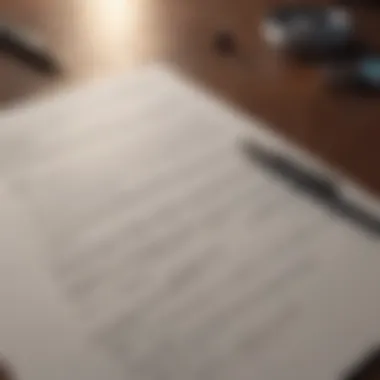Understanding Closing Letters: Their Importance and Structure


Intro
In any professional setting, formal communication is vitally essential. A closing letter symbolizes not only the conclusion of a transaction but also the end of a professional relationship. Its importance cannot be overstated, as it encapsulates critical details necessary to finalize agreements and lay the groundwork for future interactions. Miscommunication at this stage can lead to misunderstandings or even disputes.
The main purpose of this article is to shed light on the significance of closing letters, their primary components, and practical advice for writing one. By detailing salient features and providing concrete examples, this guide aims to enhance understanding and efficiency in professional correspondence. Effective communication, particularly in the closing stages, ensures clarity and can fortify professional relationships.
The Importance of Closing Letters
Closing letters serve as a means to formally document a conclusion in various settings. In both business transactions and legal affairs, they help confirm agreements and facilitate the complete understanding between parties. An effective closing letter reflects a professional’s acknowledgment of the received terms, agreements, and actions that have been taken.
Such letters serve a dual purpose: they protect individual rights while also helping to maintain goodwill for future engagements. They provide a structured summary of the engagement and can be essential when disputes arise.
Understanding Closing Letters
Understanding closing letters is fundamental in respecting and maintaining professional relationships. A closing letter signifies the end of a transaction or agreement, encapsulating all final discussions and terms. It acts as a formal confirmation that a particular engagement has reached its conclusion. This article reveals the relevance of closing letters in both business and legal contexts, emphasizing how they enhance communication and clarity when finalizing various objectives.
Definition and Purpose
A closing letter serves a well-defined role. Primarily, it captures all agreements, obligations, and understandings reached by parties involved in a dialogue. This letter aims to offer a clear overview of elements that have been resolved at the conclusion of any engagement. Clarity in communication prevents misunderstandings and outlines responsibilities. Consequently, confusion about terms and intentions can be avoided. The essence of a closing letter lies in its ability to provide a documented reference for both parties, ensuring there is no ambiguity when transitioning away from the negotiated terms.
Common Scenarios for Usage
Several scenarios exist where a closing letter is applicable. Understanding these scenarios can help to use the tool effectively. Each circumstance showcases the necessity to formalize understandings and reiterate agreed points. Its relevance in different sectors should not go unnoticed.
Business Transactions
The role of a closing letter in business transactions is critical. This aspect hinges on the smooth execution of deals. The key characteristic here is the ability to bring clarity regarding the expectations and obligations of each party post-agreement. A closing letter becomes beneficial as it solidifies relationships and confirms all conditions met prior to the transaction's completion. One prominent feature of business transactions is the confidentiality agreements contained therein; these can offer protection to the information shared. Advantages include establishing a clear understanding of future responsibilities, while drawbacks arise if key terms remain unaddressed in such correspondence.
Legal Agreements
In the realm of legal agreements, closing letters stand as essential forms of communication that commemorate engagements. Their primary function ensures that both parties are aligned concerning their commitments. This element is beneficial as it protects the legal rights of all participants of an agreement and symbolizes the closure of unfinished contracts. Uniquely, legal closing letters may contain references to much more complex arising stipulations or provisions. Their complexity can have potential disadvantages, mainly if interpretations differ regarding obligations noted within.
Client Communications
Client communication employs closing letters as a professional courtesy that embraces a client's importance to a business. These letters convey appreciation for the collaboration while summarizing achievements to foster long-term professional relationships. One defining aspect is the reassurance clients gain with documented outcomes from their negotiations. Such specificity in wording communicates reliability in future collaborations. However, the unique feature here also includes conciseness. Clients might struggle with overly technical language or insufficient clarity, highlighting a need for tailored communication approaches.
“A closing letter creates a necessary record, proudly representing a transactional journey marked by professionalism.”
Key Components of a Closing Letter
A closing letter is more than just a formality; it encapsulates a relationship’s culmination, outlining proceedings and terms as the concerned parties conclude their dealings. Understanding its essential components can enhance one's communication experience and ensure clarity, ultimately benefiting all involved. Distilling the essentials into comprehensive sections—salutation, context recap, final terms, and closing remarks—can fortify the integrity of the closure, marking it as a memorable and professional end.
Salutation and Address
The choice of salutation sets the tone for the entire letter. It reflects the relationship dynamics between the parties involved. For business settings, using titles and last names is customary; conversely, a more casual opening like “Hi” can apply if a less formal relationship exists. Accurate addresses, especially for legal documents, ensure proper delivery and attention. Missing names or errant addresses may result in confusion or miscommunications.
Key Points for a Successful Salutation:
- Use appropriate titles like Mr., Ms., or Dr.
- Ensure the recipient's name is spelled correctly
- Align the addressing format with cultural conventions, if necessary
Recap of the Context
The context recap serves as the foundational backdrop for the closing letter. It should briefly summarize what has transpired leading up to this point. This section emphasizes clarity by revisiting the main points of the engagement during your relationship. This could be tasks completed, deadlines met, or particular agreements reached. It affirms mutual understanding and reminds the recipient of why this document is being sent.


Considerations for Recapping Context:
- Keep it concise but informative, aiming for clarity over verbosity
- Restate important milestones or agreements using neutral language
- Relate it back to the key objectives pursued in the transaction to remind all parties of the shared goals
Final Terms and Agreements
This component lists the products, services, or conditions agreed upon during the course of the interaction. Detailing information here solidifies understanding and minimizes ambiguity regarding responsibilities going forward. This is crucial in both business and legal engagements. Clear stating prevents potential misunderstandings that can arise later.
Elements to Include in Final Terms:
- Restatement of obligations or agreements reached
- Timelines or essential dates related to the agreements
- Compliance requirements or consequences following any agreements
Gratitude and Closing Remarks
Concluding a letter with gratitude leaves a positive impression on the recipient. Brief thanking phrases indicate respect for their involvement and partnership, fostering goodwill even as the relationship transitions, be it ending or evolving. Crafting noteworthy closing lines allows personalality and sensitivity, especially when the situation has been rigorous. It can deeply affect the lasting connections.
Recommendations for Effective Closing Remarks:
- Begin with a simple “Thank you” or “I appreciate…” to acknowledge efforts taken by others
- Maintain a positive tone and empathetic language
- Provide lines to keep doors open for future communication
A well-structured closing letter combines key components effectively, contributing greatly to maintaining professional relationships.
The Role of Tone and Language
The tone and language used in a closing letter carry significant weight. They help convey the intended message and influence how the recipient perceives not only the communication itself, but also the relationship at large. Choosing an appropriate tone can enhance professionalism and create a positive impression. Conversely, an inappropriate tone can lead to misunderstandings or damage professional relationships.
Choosing the Right Tone
Selecting the right tone depends on the audience and context. A formal tone suits more serious business or legal proceedings, while a slightly informal tone is suitable for client communications where familiarity is established. For instance, when addressing a long-term client, using a more casual style can express appreciation and maintain warmth in the relationship. The key is to follow standard etiquette while also subtly adapting to the recipient’s communication style. This personalization fosters rapport, making the communication feel more genuine.
Some key factors to consider:
- Acknowledge the context: Understand the circumstances surrounding the communication.
- Assess your relationship: Evaluate your history with the audience—new clients versus long-established ones represent different communication needs.
- Align Interests: Ensure the tone reflects the expectations and requirements implied in previous interactions, paving a smoother relationship for future communication.
Clarity and Conciseness
Clarity and conciseness are critical when writing a closing letter. In business or legal contexts, it is not just about what you communicate, but also how effectively you convey that information. A concise approach helps avoid twisty paths and keeps the focus sharp.
When presenting final terms or agreements, it is vital to be unambiguous. For example, instead of saying:
We will work on the project sometime next month,
consider stating:
The project will commence on April , 2024.
Here are essential practices to enhance clarity and conciseness:
- Use clear language: Avoid jargon unless necessary and define complex terms when included.
- Organize logically: Structure the letter so that ideas flow naturally.
- Edit thoroughly: Remove redundant phrases that can blur the message.
- Be straightforward: Stick to essential informations, avoiding filler content that doesn’t add value.
In summary, the tone and language in a closing letter are vital for effective communication in professional environments. The right tone builds trust and respect, while clarity ensures understanding and mitigates errors in interpretation.
"A closing letter is not simply an end; it is a foundation for new beginnings in professional relationships."


By remaining attentive to tone and language, professionals can improve their correspondence's impact, enhancing their dealings with clients, partners, and stakeholders.
Practical Guidelines for Writing Closing Letters
Writing a closing letter is a nuanced skill that requires careful thought and attention to detail. Such letters often signify the end of important transactions or relationships, making it crucial for them to convey the intended message accurately and professionally. A well-structured closing letter reinforces a positive image to the recipient while ensuring full alignment with the agreement concluded. This section will outline practical guidelines for drafting effective closing letters that both meet professional standards and communicate clearly.
Step-by-Step Writing Process
To create a successful closing letter, adhere to a systematic approach. Here’s a breakdown of steps:
- Define the Objective: Understand the main purpose of the letter. Are you summarizing the final agreement, expressing gratitude, or indicating closure?
- Gather Relevant Information: Compile key points that need to be mentioned. This may include specific terms, commitments, or emotional acknowledgments pertinent to the transaction.
- Draft a Clear Structure: Organize the letter logically. Beginning with a salutatory greeting, followed by valuable context, followed by final terms and a note of gratitude usually yields lasting effects.
- Use Simple Language: Avoid overly complex sentence structures and technical jargon. Clear communication will enhance understanding.
- Be Direct: Stay focused on the objectives of your letter. If renewal is possible in the future, affirm this without deviating into unrelated matters.
- Review and Edit: After writing, you should step away temporarily. Returning with fresh eyes can help you see areas needing improvement.
Proofreading and Revising
Writing a closing letter does not end with the initial draft. Proof rereading and revising are vital to ensuring the quality of communication. Here’s how to approach the proofreading phase:
- Check for Typos and Grammatical Errors: Small mistakes can diminish professional reputation. Read through the letter carefully and perhaps employ tools like Grammarly to assist.
- Ensure Clarity and Conciseness: Trim any unnecessary words, phrases, or rambling sections to maintain focus and effectiveness in the message.
- Verify Specifics: Double-check any names, dates, and transaction details to ensure they are correct. Mistakes in these areas can lead to additional confusion.
- Seek Feedback: In some cases, having a colleague review the letter can bring an outside perspective, potentially catching errors or areas of improvement you might have missed.
- Finalize Format: Standard practices for letter layout includes adding a clear subject line, accurate salutation, and proper sign-off to finalize the document's professionalism.
“An effective closing letter demonstrates your capacity for clarity and detail, ensuring all parties feel respected and informed.”
By adhering to these guidelines, individuals can elevate their business communication through effective closing letters.
Common Mistakes to Avoid
Understanding common mistakes in closing letters is crucial for effective communication. It is easy to misstep in this formal context, which might undermine the intended message. Being aware of common pitfalls can enhance professionalism and clarity. Failing to address issues such as excessively formal language or neglecting to include essential information can lead to misunderstandings or altercations. Below are some common mistakes to avoid:
Overly Formal Language
While maintaining professionalism is important, an overly formal tone can create distance. Writing that is too stiff may not resonate with the recipient. For example, phrases such as "Henceforth" or excessive jargon make the writing seem convoluted. Striking the right balance in tone fosters better engagement and facilitates more effective communication. A slightly warmer approach can streamline connection and reflect approachability without sacrificing professionalism.
Neglecting Key Information
Omitting key details is another significant mistake that can compromise the potency of a closing letter. The recipient needs to be clear about the final terms and explored elements to reduce ambiguity. Information such as transaction dates, obligations of each party, and other binding agreements are foundational. Prioritizing clarity ensures that all parties are on the same wave length and minimizes potential conflicts that might arise post-signature. Missing critical elements might invalidate sincerity and intent, possibly causing friction in relationships.
Ultimately, avoiding these common mistakes strengthens the efficacy of closing letters. It ensures that the final communication serves its intended purpose.
Examples of Effective Closing Letters
Effective closing letters play a vital role in wrapping up various business and legal relationships. They serve as a clear and formal summary of the agreements made and the understanding reached by both parties. Including concrete examples of closing letters demonstrates how the elements combined in a well-crafter letter can tangibly impact professional interactions.
Business Transaction Example
A well-structured closing letter following a business transaction is essential for solidifying the agreement. Such a letter provides the final terms agreed upon, offering clarity to all involved. An effective business transaction closing letter typically includes:
- Date of transaction
- Parties involved
- Recap of essential terms
- Confirmation of payment details
- Request for feedback or acknowledgment
For instance, after acquiring a business, a buyer may send a closing letter to the seller confirming the terms like the sale amount and transfer of assets. This kind of communication ensures both parties have aligned expectations going forward while minimizing future disputes.
Client Communication Example
In the context of client relations, a closing letter acts as an official communication of the closure of a project or engagement. It highlights important milestones reached, demonstrates gratitude for the client's collaboration, and outlines any follow-up actions.
When drafting a client communication closing letter, key elements may include:


- Recognition of the relationship
- Summary of services rendered
- Assessment of satisfaction and outcomes
- Next steps, if applicable
For example, when a consultant completes a project for a client, they can send a letter summarizing findings, deliverables, and overall success. This not only acknowledges the significance of the partnership but also bolsters ongoing professional relationships.
Legal Agreement Example
Closing letters tied to legal agreements are crucial in demarcating commitments. These letters act as a confirmed record that ensures both parties comply with the legal obligations stated in signed documents.
In an effective legal agreement closing letter, important components would be:
- Overview of the agreement
- Affirmation of compliance
- Implications for both parties
- Contact information for clarifications
For instance, after a contract has been executed for a service delivery, a closing letter can restate the commitments outlined. Reinforcing expectations is paramount in legal contexts, helping prevent potential litigation down the road.
Overall, effective closing letters cannot be underestimated. They lay the groundwork for professional confidence, efficiency, and continual collaboration across various industries.
The Impact of Closing Letters on Professional Relations
Closing letters play a vital role in shaping professional relationships in various contexts, be it legal frameworks or business settings. They serve to finalize and solidify agreements reached, reflecting mutual respect between parties. In addition to serving as a formal communication tool, closing letters also communicate essential details that may have been previously discussed. This dual purpose enhances professionalism and clarity, key elements for successful relations.
Enhancing Professional Image
Signal professionalism is essential in interpersonal engagements, and closing letters enable this through careful articulation of agreements. When a closing letter is well-structured and explicitly summarizes the terms agreed upon, it reflects a level of dedication that others in the field respect. It is also a subtle indicator of one's attention to detail.
Additionally, conveying termination or completion of a transaction through a formal letter fosters an atmosphere of professionalism. It elevates one's standing within an industry and elevates perception in the eyes of clients or other stakeholders. Hence, closing letters serve as a narrative that emphasizes the efficacy and thoroughness individuals espouse at work.
Building Trust and Credibility
When resolutions and agreements are laid out clearly in a closing letter, trust and credibility naturally follow. A well-composed letter can mitigate misunderstandings that might arise from verbal discussions or misunderstandings in digital communication. When both parties possess a document confirming their mutual agreement, it fosters an environment built on clear communication and honesty.
Furthermore, consistent use of closing letters in business transactions reflects an individual's or organization’s dedication to transparency. Such transparency generates confidence among partners and clients alike. Creating a culture where clear communication is prioritized reinforces the trustworthiness of the involved parties, greatly enhancing long-term professional fellowship.
In summary, closing letters are an essential tool for establishing a deepening bond of trust and enhancing one's image in various professional realms.
Through the use of well-comosed closing letters, you create a solid foundation for successful engagement and long-lasting partnerships. Integrating them into your professional practices not happens to be prudent, but also invaluable. Establishing these practices is consequential in forming circle relations and securing future endorsements.
Closure and Final Thoughts on Closing Letters
Closing letters hold significant weight in various professional interactions. They serve as formal documents that mark the conclusion of transactions, agreements, and relationships. By crafting an appropriate closing letter, one communicates respect and acknowledgment of the processes undertaken. This fosters goodwill, a sometimes understated yet crucial component in any business or legal engagement.
In this article, we’ve dissected the essential elements and importance of closing letters. Understanding their structure is vital. Components such as salutations, context recaps, final terms, and expressions of gratitude form the skeletal framework that supports the letter’s purpose. It is not simply a formality; a well-crafted closing letter reflects one's professionalism and sets the tone for future interactions.
Moreover, tone and language are instrumental in shaping how the message is perceived. The right tone conveys sincerity and professionalism, whereas dismissive or overly formal language can cause miscommunications or leave a lingering negative impression. By choosing language that is both clear and appropriate, one manages to enhance communication effectiveness and clarity.
Such letters leave lasting impressions on recipients. The way they convey finality shows one’s appreciation for the steps that led to closure. Whether in scenarios of business transactions or client communications, these letters not only highlight one's image but also the reliability of their engagements. In turn, this enhanced image contributes positively to trust-building and credibility in professional relationships.
A skillfully crafted closing letter can elevate professional interactions and foster ongoing relationships.
Summary of Key Takeaways
- Closing letters serve crucial functions in finalizing transactions or professional relationships.
- Key components include salutation, context, final agreements, and gratitude.
- The tone of a closing letter is vital; the right tone fosters trust and credibility.
- Clarity and proficiency in language enhance the effectiveness of communication.
- Without proper attention, common mistakes can be made, which can diminish the letter's effectiveness.
Encouragement for Practice
Writing closing letters is a practice of finesse and understanding the particular scenario. Start by drafting your letters following the outlined components. Take feedback from peers or mentors to identify areas for improvement.
Consider exploring different contexts where closing letters may apply. Familiarize yourself with examples related to business transactions or client agreements. The more you engage with this writing process, the more fluent you will become.
Regular practice enhances skill, settles instincts, and ultimately builds confidence in your professional communications. Transitioning from initial drafts to final versions can unveil patterns in your writing style that serve you well across different professional scenarios.



